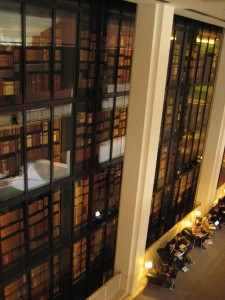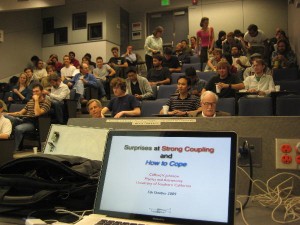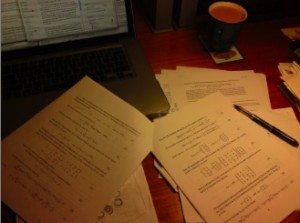 …more to go. I’ve finished one of the papers I’ve been writing (this one co-authored with my student, Tameem) after delaying on it for months. I’m not sure how things got quite this backed up in terms of things I have to do, but they have. I meant to start on a new, long project last week, and all my efforts these days have been toward clearing away all those things I want to get done and dusted before focusing on that. It is taking time, but gradually the clearing is happening. Two more manuscripts to complete.
…more to go. I’ve finished one of the papers I’ve been writing (this one co-authored with my student, Tameem) after delaying on it for months. I’m not sure how things got quite this backed up in terms of things I have to do, but they have. I meant to start on a new, long project last week, and all my efforts these days have been toward clearing away all those things I want to get done and dusted before focusing on that. It is taking time, but gradually the clearing is happening. Two more manuscripts to complete.
This paper reports on the continuation of the work we’ve been doing over the years in understanding the physics of various model systems in an applied magnetic field. This is in the context of holographic models of important strongly coupled phenomena that are of considerable interest in lots of fields of physics (particle physics, nuclear physics, condensed matter physics, atomic physics). (Since I don’t want to explain holography and so forth every time I talk about it, see a post I did about some of that here, and related posts in the list at the bottom of this one, if not sure what I’m talking about.) (Hmmmm, I see from my SPIRES listing that I’ve got seven papers mentioning magnetic field explicitly in the title in the last three years, and three or four more of the rest are occupied in large part with the issue too. No, really, I’m not obsessed.)
The issue here is the study of structures that suggest themselves as earmarks of Fermi surfaces in strongly coupled systems. It has been a goal for a long time in the context of gauge/gravity duals to understand what the signals of a Fermi surface would be. Would it be some geometrical object in the dual gravity theory, perhaps? Access to a computationally tractable description of such an object would be rather […] Click to continue reading this post →
 Oh! I almost forgot to remind local readers that the next Southern California Strings Seminar is happening this week. Friday and Saturday. It will be at UCLA, and there’s a great line up of speakers. As I’ve said here before, graduate students are especially encouraged to come…
Oh! I almost forgot to remind local readers that the next Southern California Strings Seminar is happening this week. Friday and Saturday. It will be at UCLA, and there’s a great line up of speakers. As I’ve said here before, graduate students are especially encouraged to come…
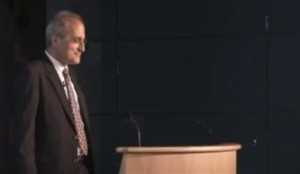

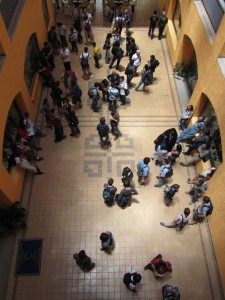
 One of the things I worked a lot on in earlier months this year (and late ones of last year) was the lead article in a cluster of articles that has appeared in the last few days in May’s special edition of Physics Today. They are sort of departmental-colloquium-level articles, so for a general physics audience, more or less. It’s about some of the things I’ve told you about here in the past, concerning exciting and interesting applications of string theory to various experiments in nuclear physics, as well as atomic and condensed matter physics (although we do not have an article on the latter in this cluster). I had a fun time working with Peter Steinberg on the article and remain grateful to him for getting us all together in the first place to talk about this topic way back in that AAAS symposium of 2009. It was there that Steven Blau of Physics Today got the idea to approach us all to do an article, which resulted in this special issue.
One of the things I worked a lot on in earlier months this year (and late ones of last year) was the lead article in a cluster of articles that has appeared in the last few days in May’s special edition of Physics Today. They are sort of departmental-colloquium-level articles, so for a general physics audience, more or less. It’s about some of the things I’ve told you about here in the past, concerning exciting and interesting applications of string theory to various experiments in nuclear physics, as well as atomic and condensed matter physics (although we do not have an article on the latter in this cluster). I had a fun time working with Peter Steinberg on the article and remain grateful to him for getting us all together in the first place to talk about this topic way back in that AAAS symposium of 2009. It was there that Steven Blau of Physics Today got the idea to approach us all to do an article, which resulted in this special issue.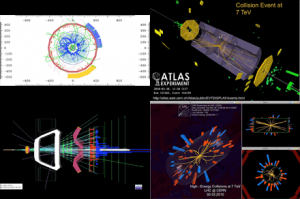
 …more to go. I’ve finished one of the papers I’ve been writing (this one co-authored with my student, Tameem) after delaying on it for months. I’m not sure how things got quite this backed up in terms of things I have to do, but they have. I meant to start on a new, long project last week, and all my efforts these days have been toward clearing away all those things I want to get done and dusted before focusing on that. It is taking time, but gradually the clearing is happening. Two more manuscripts to complete.
…more to go. I’ve finished one of the papers I’ve been writing (this one co-authored with my student, Tameem) after delaying on it for months. I’m not sure how things got quite this backed up in terms of things I have to do, but they have. I meant to start on a new, long project last week, and all my efforts these days have been toward clearing away all those things I want to get done and dusted before focusing on that. It is taking time, but gradually the clearing is happening. Two more manuscripts to complete.